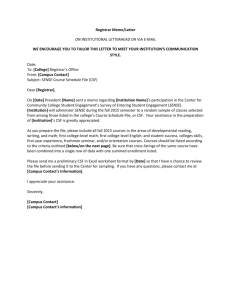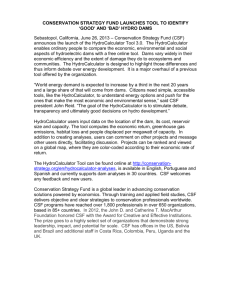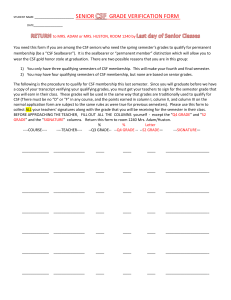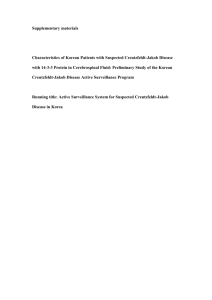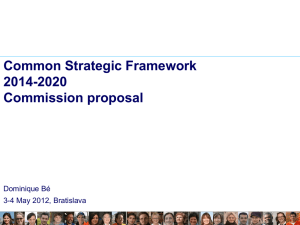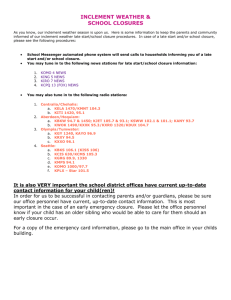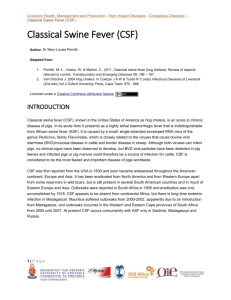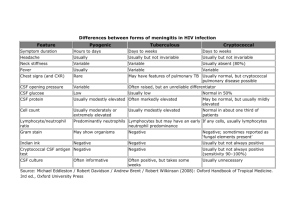Full text - Art and Science of Neurosurgery
advertisement
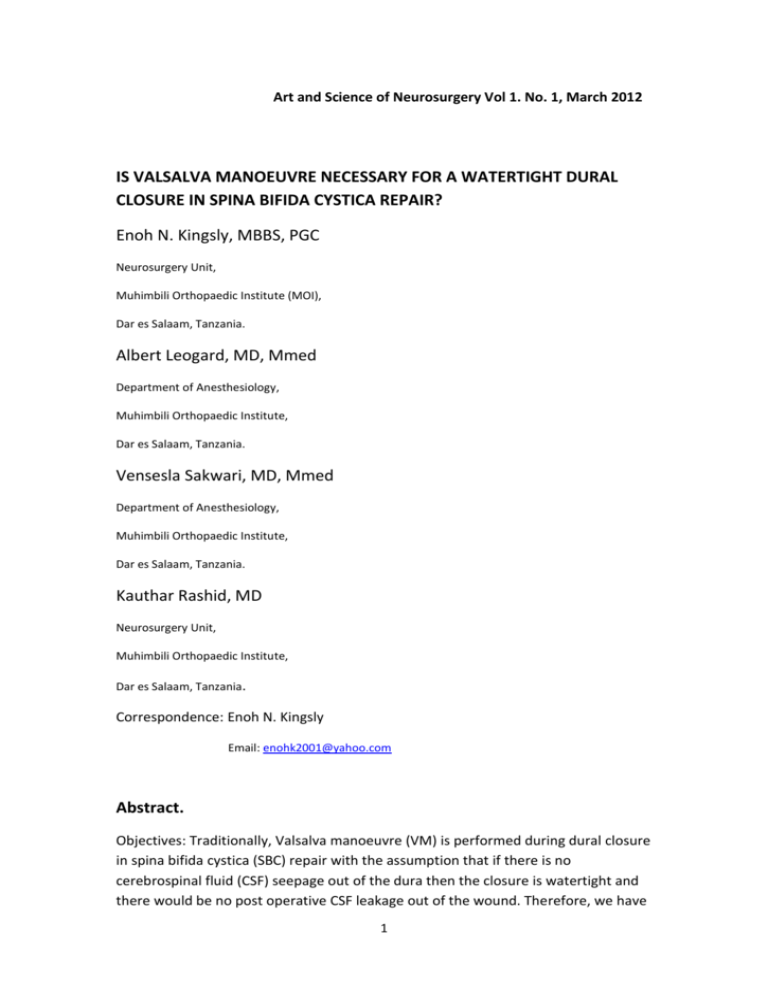
Art and Science of Neurosurgery Vol 1. No. 1, March 2012 IS VALSALVA MANOEUVRE NECESSARY FOR A WATERTIGHT DURAL CLOSURE IN SPINA BIFIDA CYSTICA REPAIR? Enoh N. Kingsly, MBBS, PGC Neurosurgery Unit, Muhimbili Orthopaedic Institute (MOI), Dar es Salaam, Tanzania. Albert Leogard, MD, Mmed Department of Anesthesiology, Muhimbili Orthopaedic Institute, Dar es Salaam, Tanzania. Vensesla Sakwari, MD, Mmed Department of Anesthesiology, Muhimbili Orthopaedic Institute, Dar es Salaam, Tanzania. Kauthar Rashid, MD Neurosurgery Unit, Muhimbili Orthopaedic Institute, Dar es Salaam, Tanzania. Correspondence: Enoh N. Kingsly Email: enohk2001@yahoo.com Abstract. Objectives: Traditionally, Valsalva manoeuvre (VM) is performed during dural closure in spina bifida cystica (SBC) repair with the assumption that if there is no cerebrospinal fluid (CSF) seepage out of the dura then the closure is watertight and there would be no post operative CSF leakage out of the wound. Therefore, we have 1 Art and Science of Neurosurgery Vol 1. No. 1, March 2012 asked the question: is VM really necessary in preventing CSF leakage after SBC repair? Methods: Patients who underwent SBC repair at our institution over a one year period (from November 2010 to October 2011) were prospectively studied by dividing them into two equal groups: one group had VM performed during dural closure and the other group did not. Patient's age, gender, type of SBC, neurological deficits, presence or absence of CSF leakage or infection at the operation site (within 7 to 10 days) post-operatively and outcome at follow up after one month were noted. Results: There was a total of 22 patients in the series, consisting of 12 males and 10 females. The mean age at SBC repair was 6.1 months (range 3 to 12 months). There were 20 myelomeningocoeles (MM's), one meningocoele, and one split cord malformation Type II (SCM II). Of the 11 patients in the group which had VM performed during dural closure, two patients had CSF leakage and amongst the two, one also had wound infection in the first 10 days after surgery. Of the other 11 patients in the group which did not have VM performed during dural closure, one patient had CSF leakage and none had wound infection. There was no significant difference in post-operative CSF leakage between the two groups (P = 0.56). Overall, outcome was good at one a one-month follow up. Conclusion: Despite the fact that VM is traditionally performed during dural closure in SBC repair as a means of verifying a watertight closure, our series would suggest that it is not necessary for adequate dural closure and prevention of post-operative CSF leakage. Key words: Valsalva manoeuvre, spina bifida, CSF leakage. Introduction. Valsalva manoeuvre (VM) was first described by Antonio Valsalva (1666-1723), an Italian anatomist and physician. It is essentially a forced expiration against a closed glottis after full inspiration. At first, used to expel pus from the middle ear; it was later used for bedside evaluation of heart murmurs and as an adjunct for evaluation of left ventricular function and autonomic dysfunction (2, 10, 14). The VM has been described to consist of four phases. In phase I, increase in intra-thoracic pressure 2 Art and Science of Neurosurgery Vol 1. No. 1, March 2012 causes blood to be expelled from thoracic vessels. In phase II, a reduction in venous return is caused by the increase in intra-thoracic pressure, lowering the preload and blood pressure. Baroreceptor reflex is activated, causing vasoconstriction and tachycardia, raising the blood pressure to normal. Phase III is characterized by pooling of blood in the pulmonary vessels due to a further drop in intra-thoracic pressure, leading to a further drop in blood pressure. In phase IV, a restoration of venous return causes an overshoot- as compensatory mechanisms continue to operate, the increased blood pressure leads to a baroreceptor mediated bradycardia (2). A standardized form of VM is a pressure of 40 mmHg, held for a period of 10 seconds (2). During phase I of the manoeuvre, the sudden expulsion of blood from thoracic vessels causes a sudden rise in intracranial pressure, which is also transmitted to the spinal cord. Because of the transmitted pressure to the cord, any defect in the dura and arachnoid will be noticed by CSF seeping out of it. With an adequate (watertight) closure of the defect, no CSF will be seen to seep out during VM. The VM manoeuvre is associated with a transient rise in intracranial pressure and increased cardiovascular risks (8, 11, 13, 19) .Despite this fact, some neurosurgeons traditionally use it, to verify and ensure a watertight dural closure during spinal bifida repair (5, 18). Patients and Methods. Patient population and selection. Patients who underwent SBC repair at our institution by a single surgeon (the lead author) over a period of one year (from November 2010 to October 2011) were prospectively studied by dividing them into two equal groups: one group had VM performed during dural closure and the other group did not. All the patients were children (age range 3 to 12 months), and informed consent was obtained from the parents prior to surgery and enrolment in the study. Patient's age, gender and neurological deficits were recorded in their files and standard charts; the type of SBC was noted on clinical examination and confirmed during surgery. Presence or absence of CSF leakage and/or infection at the operation site in the first 10 days post surgery were noted and each patient's outcome at one month after operation was also noted, during a follow up visit at the outpatient clinic. Operative technique. 3 Art and Science of Neurosurgery Vol 1. No. 1, March 2012 The goals of surgery are essentially the same, whether the repair is done in utero or after birth. They are: to protect the neural elements, remove excess skin tissue, obtain a watertight dural closure and prevent infection without exacerbating neurological deficits (1, 3, 4, 5, 6, 7, 9, 15, 17, 18 ). At induction of anesthesia, intravenous Ceftriaxone (50 mg/kg) is given as prophylaxis. Under general anaesthesia the child is placed prone on the operating table with the head on a head ring and small padded rolls under the shoulders and hip. The head is placed slightly lower than the back to avoid rapid egress of CSF from the sac when opened and escape of air into ventricles. The anus is sealed off from the operating field by holding the two buttocks together with and adhesive tape. Pressure areas at the extremities are padded with towels. The operative site and the SB are cleaned with Betadine; ensuring contact of the antiseptic with any exposed neural tissue is avoided. Drapes are applied with generous skin exposed so that extensive skin flaps can be mobilized. The skin is incised circumferentially immediately adjacent to the exposed meninges, in an area free of neural elements. The skin edges are retracted laterally and the incision is carried down to the meningeal sac. Once the wall of the sac is identified, it is gently dissected off the skin and sometimes peels off easily. If rupture of the sac occurs, nerve roots that course back into the spinal canal are mobilized. Sometimes, atretic neural elements that terminate in the sac itself are met and must be sacrificed. When the neural elements and placode are completely dissected away from the skin, they will lie freely in the everted dural sac. The ends of the bifid spinal canal are then searched for any bony or fibrous spur which must be resected if found. We did not find any spur, in our series. The filum terminale is also searched for and if identified, resected to avoid cord tethering. The edges of the neural placode are then folded and sutured with interrupted 6/0 vicryl to restore the configuration of the spinal cord. The dura is dissected from the subcutaneous tissue and lumbosacral fascia and closed with 4/0 vicryl. A watertight closure is verified by asking the anaesthetist to perform a VM (pressure of 30 to 40 mmHg) and to stop on the count of 10, as fast as he/she can. If any CSF leakage from the dura was encountered, dural closure was reinforced with more sutures until no CSF leakage was seen. This was done in 11, out of the 22 patients in the study. 4 Art and Science of Neurosurgery Vol 1. No. 1, March 2012 The skin margins are undermined as far laterally in the flanks as possible so that the wound can be closed with minimal tension. Redundant skin is excised; the subcutaneous tissue is closed with vicryl 3/0, and the skin closed with nylon 3/0. A dry gauze dressing is applied on the wound and the child is nursed prone or on the side for 3 to 4 days after surgery to prevent undue pressure to the fresh surgical wound and allow dependent drainage of urine and faeces. Antibiotic coverage with intravenous Ceftriaxone is continued for a period of 72 hours after operation. Post-operative assessment and follow up. In the ward the dry gauze dressing over the wound is examined twice daily, (morning and evening) for presence or absence of wetness and/or pus. When wetness is present, the dressing is removed and examined for any point of leaking of CSF from the wound. Another dry gauze dressing is then replaced and observation of the patient and wound continued, in like manner, for up to 7 to 10 days after surgery. If pus is present, a swab is taken for culture and sensitivity and post operative antibiotics continued until results of culture are obtained, then changed accordingly. Discharge from the ward is done on the 7th to 10th day, when the wound is healed and stitches removes. The child's parent is then given a date for follow up visit at the outpatient clinic, one month from day of discharge. At the outpatient clinic, the operation site was examined and outcome of wound healing as well as any deterioration in neurological deficit was recorded as either good or poor. A good outcome was considered as healing without excess scar tissue or stitch fistulae as well as absence of any deterioration of neurological deficits .A poor outcome was considered as healing with excess scar tissue and/or stitch fistulae and any deterioration in neurological deficits. Statistical Analysis. Analysis of data was done using SPSS. A descriptive statistical analysis of recorded variables was done considering all the patients in the study as a single group. Comparison of postoperative CSF leakage in those who had VM performed during dural closure and those who did not have VM performed was done using Wilcoxon signed ranks test, with statistical significance set at p < 0.05. Results. 5 Art and Science of Neurosurgery Vol 1. No. 1, March 2012 Over the study period, 22 patients underwent SBC repair by a single surgeon at Muhimbili Orthopaedic Institute (MOI), Dar es Salaam, Tanzania. Twelve patients were male (54%) and 10 (45%) were female. The age range was 3 to 12 months with a mean age of 6.1 months. Of the SBC's repaired 20 (90%) were myelomeningocoeles, one (4.5%) was a meningocoele and one (4.5%) was SCM II. All The SBC's (100%) occurred at the lumbosacral area. The type of SBC repaired, age range and gender of the patients is shown in Table 1. Age (months) Male Female Myelomeningocoele Meningocoele SCM II 3.0 -6.0 8.0 3.0 9.0 0.0 1.0 6.1-9.0 3.0 5.0 8.0 0.0 0.0 9.1-12 1.0 2.0 3.0 1.0 0.0 Total 12.0 (54%) 10.0 (45%) 20 (90%) 1.0 (4.5%) 1.0 (4.5%) Table 1. Type of SBC, patients' age range and gender. The patients were divided into two groups. One group (11 patients) had VM performed during dural closure and the other group (11 patients) did not. Post operatively, two patients had CSF leakage from the operation wound in the group that had VM performed and one patient had CSF leakage in the group that did not have VM performed. Of the two patients that had CSF leakage in the group that had VM performed, one also had wound infection (Table 2). CSF leakage No CSF leakage Infection No Infection VM 2.0 (18.2%) 9.0 1.0* (9.1%) 10.0 No VM 1.0 (9.1%) 10.0 0.0 11.0 Total 3.0 19.0 1.0 21.0 Table 2. Post operative CSF leakage. *This patient also had CSF leakage. The presence of any difference in post operative CSF leakage between the group that had VM performed during dural closure and the group that did not, was assessed by 6 Art and Science of Neurosurgery Vol 1. No. 1, March 2012 applying a Wilcoxon signed ranks test. There was no significant difference in post operative CSF leakage between the two groups (P = 0.56). At follow up in the outpatient clinic at one month after discharge, all the patients (100%) had no excess scar tissue, stitch fistulae or deterioration in neurological deficits. The outcome was considered to be good for all of them. Discussion. In our study, we have shown that there was no significant difference in post operative CSF leakage after SBC repair in the patients who had VM performed during dural closure and those who did not ( P = 0.56). While some neurosurgeons have described SBC repair (3, 4) without mentioning VM, there is a paucity of studies in the literature which have actually looked at post operative CSF leakage when VM is performed or not performed during dural closure. Therefore, our series may serve as a reference. In our series, we did not inject the SBC with lidocaine/adrenaline solution or use musculocutaneous flaps for closure as described by others (1, 3, 4, 17). There was no post operative meningitis or deterioration of neurological deficits as reported by others (4, 12, 15, 16). The fact that patients with SBC usually have other congenital anomalies including those of cardiac origin coupled with the fact that VM has increased cardiovascular risks, great care should be taken when performing VM in these patients (1, 2, 5, 8, 10, 11, 13, 14, 15). Limitations of the study. The small size of the patient population enrolled in this study is the first limitation. In addition, four of the patients enrolled in the study had ventriculo-peritoneal (VP) shunts inserted prior to the SBC repair. It may, therefore, be assumed that presence of the VP shunts in these four patients aided in preventing CSF leakage after SB repair as diversion of CSF was going on before repair. Furthermore, there was a single meningocoele repaired with myelomeningocoeles (the rest of the SBC's in the study). These are two different variations of SBC and different results are expected. The patient with meningocoele was put in the group in which VM was performed during dural closure and did not have any post -operative CSF leakage. 7 Art and Science of Neurosurgery Vol 1. No. 1, March 2012 Conclusion. Some neurosurgeons advocate the performance of VM during dural closure in SBC repair in order to verify and ensure a watertight dural closure. Our series may suggest that VM is not necessary during dural closure in SBC repair. Further studies are needed to through more light on the issue. Disclosure. The authors have no personal financial or institutional interest in any of the drugs, materials or devices mentioned in this article. References. 1. Alan RC, Shenandoah R: Myelomeningocele and myelocystocele. In: Youman's neurological surgery. Richard HW (Editor). 5th Edn. Philadelphia. Saunders, 2004: pp 3215-3. 2. Anaesthesia uk: Valsalva manoeuvre [updated 2011, cited 14/12/2011]. Available from httpo://www.frca.co.uk/article.aspx?articleid=100372 3. BB Shehu: Repair of myelomeningocele: How I do it. JSurgTechCaseReport 1 (1): 42-47, 2009. 4. BB Shehu, EA Ameh, NJ Ismail: Spina bifida cystic: selective management in Zaria, Nigeria. Annals of Tropical Paediatrics 20 (3); 239-243, 2000. 5. Daniel H et al: Surgery of the Paediatric Spine. New York. Thieme, 2008: p 204. 6. Danielle SW et al: The rationale for in utero repair of myelomeningocele. Fetal Diagn Ther 16: 312-322, 2001. 7. De Brito Henriques JG, Filho GP, Gusmao SW et al: Intraoperative acute tissue expansion for the closure of large myelomeningoceles. J Neurosurg 107: 98-102, 2007. 8 Art and Science of Neurosurgery Vol 1. No. 1, March 2012 8. De Mattial t al: Polymorphic ventricular tachycardia induced by Valsalva maneuver in a patient with paroxysmal supraventricular tachycardia. Europace 2011, Nov 23 (Epub ahead of print) 9. Enrico D, Alan WF: In utero repair of myelomeningocele: Rationale, initial clinical experience and randomized controlled prospective clinical trial. Neuroembbryology and Aging 4: 165-170, 2006/2007. 10. Felker GM et al: The Valsalva maneuver: a bedside "biomarker" for heart failure. Am J Med 119 (2): 117-22, 2006. 11. HL Price, EH Conner: Certain aspects of the hemodynamic response to valsalva maneuver. J Applc Physiol 5 (8): 449-456, 1953. 12. Idowu OE, Apimeye RA: Outcome of myelomeningocele repair in Sub-Saharan Africa: the Nigerian experience. Acta Neurochir (Wien) 150: 911-3, 2008. 13. Ikeda ER et al: The Valsalva Maneuver Revisited: the influence of voluntary breathing on isometric muscle strength. JSC 23 (1): 127-132. 14. Nishimura RA, Tajik AJ: The Valsalva maneuver and response revisited. Mayo Clin Proc. 61 (3): 211-7, 1986. 15. Noel T, Joseph PB: Myelomeningocele repair in utero: A report of three cases. Paed Neurosurg 28: 177-180, 1998. 9 Art and Science of Neurosurgery Vol 1. No. 1, March 2012 16. Talamonti G, D'Aliberti G, Collice M: Myelomeningocele: long term neurosurgical treatment and follow up in 202 patients. J Neurosurg 107: 368-86, 2007. 17. Turhan H et l: Repair of wide myelomenigicele defects with bilateral fasciocutaneous flap method. Turk Neurosurg 18: 311-5, 2008. 18. W. Bruce Cherny: Myelomeningocele reapir. Barrow Quarterly 16 (4); 2000. 19. Yeom JS et al: exaggerated valsalva maneuver may explain stretch syncope in an adolescent. Pediatric Neurol 45 (5): 338-40, 2011. Art and Science of Neurosurgery Vol 1. No. 1, March 2012 10
